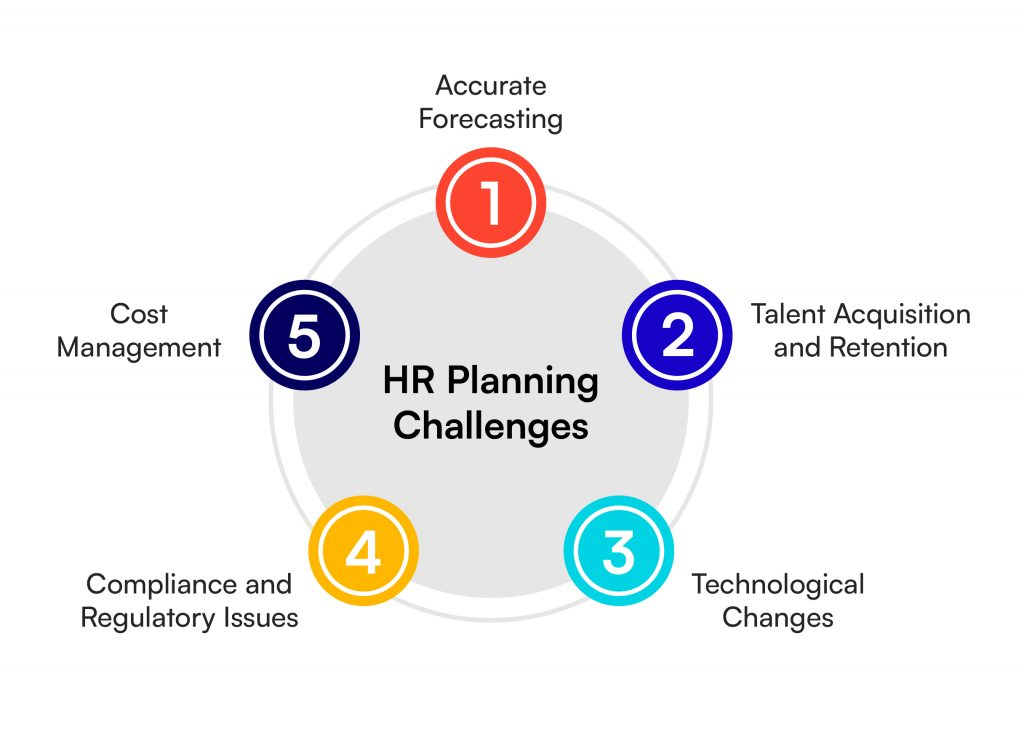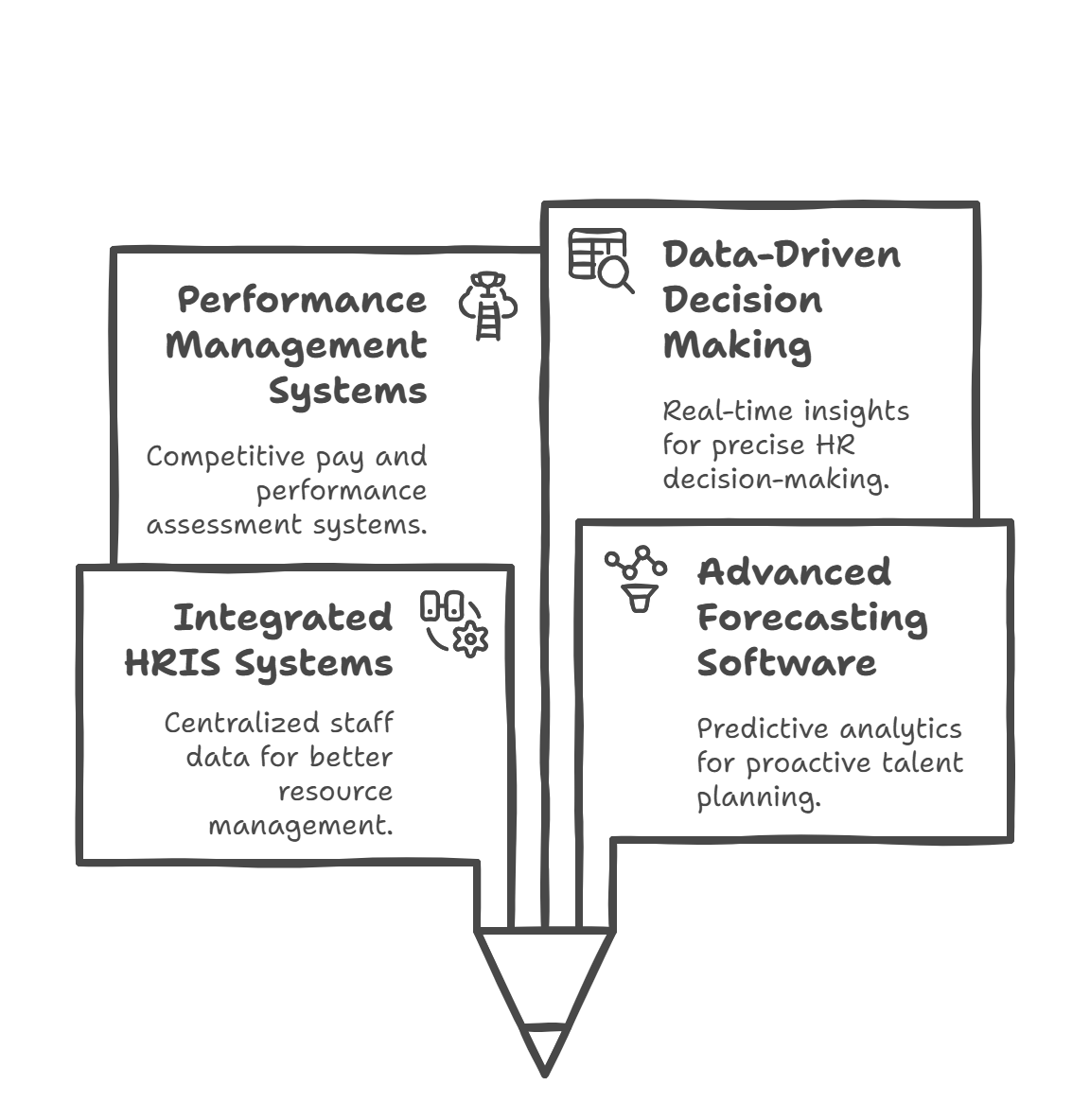Summary
Through this detailed approach to Human Resource Planning, we cover essential steps from evaluating current workforce capabilities to forecasting future needs and developing tailored HR strategies. We guide you on how to do it while ensuring business continuity.
Organizational success depends mainly on effective human resource planning (HRP).
Our HR projects support corporate goals. They help build strong teams that are ready for the future.
This article discusses HRP. It includes process mapping, strategic alignment, tech-driven insights, and future trends.
What is Human Resource Planning?
Human resource planning (HRP) is the process of ensuring that a company has the right people in the right roles at the right time.
We stress the importance of aligning HR operations with company goals. This helps drive growth and ensures stability. HRP boosts productivity and cuts risk. It does this by forecasting talent needs and supplies.
Why HRP is Essential
-
- Strategic Alignment: We match long-term corporate goals with HR projects.
- Correct forecasting helps to avoid overstaffing and understaffing.
- Active planning tackles possible disruptions and talent shortages.
- Customized training and career planning increase employee retention and involvement.
- Good HR policies respect labor laws and ethical standards. This ensures compliance with legal and regulatory requirements.

Key HR strategies align to create effective HR planning
The Human Resource Planning Process
Our human resource planning process centers on a set of well-defined actions. Every action aims to assess current performance.
It helps identify future needs and apply plans to close potential gaps.
Step-by-Step HR Planning Process

-
- Define Organizational Objectives. First, we identify our strategic goals. Then, we guide every part of the company toward these goals. This clarity defines every HR decision taken afterward.
- Assess Current Workforce Planning starts with a baseline. This comes from a careful look at our staff’s performance, knowledge, and experience. We examine workforce numbers and skills. This helps us spot strengths and limitations.
- Predict Future HR Needs We can predict staffing needs by looking at past data and current trends. This helps us understand the personnel required for the upcoming business expansion. One has to expect influences from rivals, the economy, and technology.
- Conduct Gap Analysis We compare current skills with future needs. This helps us find areas where talent may be missing. Our work consists of qualitative and quantitative assessments.
- Develop Strategic HR Initiatives To address the gaps, we create targeted plans. These include retention strategies, training courses, and recruitment campaigns. These programs aim to meet both long-term expansion and immediate demands.
- Execute and Track HR Plans Make HR ideas align with everyday business processes we track key performance indicators (KPIs) on a regular basis to adjust the plan.
Enhancing Organizational Success with Effective HR Planning
Effective HRP is a strategic facilitator pushing corporate evolution, not a process. Our strategy ensures that every staff member can reach the company’s goals.
Aligning HR Strategies with Business Goals
We combine HR plans with general corporate strategy. Including HR talks in board meetings boosts staff planning. This leads to better efficiency, increased revenue, and more innovation. These elements work well together.
-
- The team assesses every HR project in relation to profitability and competitive advantage.
- Building cross-functional skills and talent pipelines boosts our workforce flexibility. This increase comes from greater agility and resilience.
Maximizing Workforce Utilization
Optimal resource allocation means our HRP systems track personnel performance. This helps us boost effectiveness and reduce resource waste.
-
- Real-time performance trend analysis, made possible by advanced HR analytics solutions, drives insights.
- Regular performance reviews help our staff meet new challenges and improve our plans.
Strategies for Superior Human Resource Planning
To achieve HR planning excellence, create plans that fit today’s market. We differentiate ourselves with sophisticated technologies and improved approaches.
Leveraging Advanced HR Analytics and Technology
-
- Predictive analytics uses statistical models. It helps us see future skill needs and market changes.
- Our integrated HR systems simplify employee engagement, performance management, and recruiting.
- Customized dashboards provide essential insights at a glance, enabling quick decisions.
Proactive Workforce Management
-
- We run several corporate scenarios to get ready for possible developments and uncertainties.
- Integrated Communication Systems: Departments link up to keep HR updated on company changes.
- Talent Pipeline Development: We support ongoing education and mentoring. This helps us grow future leaders from within the company.
Enhancing Employee Engagement and Development
Building a committed workforce requires a balance. You must meet operational needs while also keeping employees happy.
-
- Tailored career development programs handle both personal development and group organizational needs.
- Regular performance evaluations and feedback sessions boost professional growth. They also align individual efforts with company goals.
- Good reward systems make staff feel valued and motivated.
Addressing Challenges in HR Planning
The success of any HR planning relies on spotting and overcoming obstacles. We confront challenges with flexible and pragmatic solutions.
 Common HRP Challenges
Common HRP Challenges
-
- Forecasting Uncertainties: Predicting future demand is tough. Market changes and tech disruptions make it even harder.
- Quick changes in the sector call for ongoing staff skill development.
- Workforce flexibility presents continuous difficulties when juggling temporary help with permanent roles.
- Launching new HR projects can boost morale and overcome resistance to change.
Our Approach to Overcoming Challenges
-
- Accurate projections depend first on ensuring data integrity and authenticity.
- We create an atmosphere that welcomes change and lifetime learning.
- Good leadership and open talks help reduce pushback and link staff to new projects.
- Our HR team creates flexible plans. This helps us respond with speed to unexpected changes.
Tools and Techniques for Effective Human Resource Planning
Modern HR planning uses new tools and techniques. These help with smart decision-making.

Core tools and tech that power effective human resource planning
HR Information Systems (HRIS)
We use integrated HRIS systems to compile staff data from several points of view. This integration makes it easier to see everything and organizes resources well.
Advanced Forecasting Software
Our HR systems predict talent needs. They use past performance and current market trends. This helps us carry out focused plans much ahead of need.
Performance and Compensation Management Systems
Strong platforms help develop competitive pay systems and assess employee performance. These methods guarantee industry standards and help us keep top staff.
Data-Driven Decision Making
We focus on data-driven insights. This changes HR procedures and enables practical, precise decisions. We use systems like interactive dashboards and automated reporting. They help HR teams and business executives connect in real time.
The Future of Human Resource Planning
Human resource planning is undergoing continuous changes in the landscape. We stay ahead by using future-focused methods and embracing new technology.
Anticipating Future Trends
-
- Machine learning and AI help automated systems boost staff growth, screening, and recruitment.
- Our solutions help remote teams work smoothly with main operations.
- We know that well-being boosts productivity. So, we include strong wellness programs in our HR budget.
Strategic Adaptation for Long-Term Success
Staying updated on industry changes helps us prepare for future challenges. Our plans help us stay agile in a changing business world. This boosts our market position.
Conclusion
Our Human Resource Planning helps the organization succeed in the long run. It also encourages adaptability among workers and supports growth. We build strong teams through accurate forecasting, strategic alignment, and continuous growth. Tech-driven methods and flexible planning help each HR project meet our main goals.
A strong HR planning strategy gives us an edge in today’s changing market. This approach strengthens our company for current success and future challenges.
About Remunance
Remunance is an Employer of Record (EOR) services provider in India, helping global companies hire, manage, and support full-time employees without setting up a local entity. We take care of HR, payroll, compliance, and benefits so businesses can focus on growth while building their teams in India with confidence.
Remunance enables businesses from UK, Australia, Canada, France, US, and the Middle East to recruit, hire, and manage workforce and benefits in India.
FAQs
What are three components of human resource planning
The key components are HR demand forecasting, HR supply analysis, and HR strategy development. These elements work together to align talent needs with business objectives.
Why do we need human resource planning?
HR planning ensures the right talent is available when needed, preventing staffing shortages or surpluses. It supports both immediate operations and long-term strategic goals.
What are the 5 steps in human resource planning?
The steps are: define objectives, assess the current workforce, forecast future needs, perform gap analysis, and implement strategies. Each step builds a clear roadmap for managing talent effectively.
Why is human resources planning important?
It aligns workforce capabilities with business goals and prepares the organization for future challenges. This alignment drives productivity and operational efficiency.
What are the benefits of human resource planning?
Benefits include optimized staffing levels, enhanced employee development, reduced operational risks, and improved cost management. It enables organizations to remain agile and competitive.
How does human resource planning contribute to organizational success?
Effective HR planning builds adaptable teams that can drive innovation and growth. By aligning HR practices with strategic goals, it enhances overall organizational performance.


